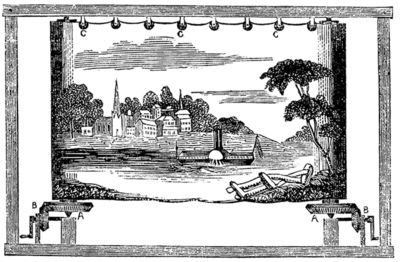Moving panorama: Difference between revisions
imported>Russell Potter (Contnet not "originally" from WP; see Talk page) |
imported>Petréa Mitchell m (Big Cleanup) |
||
| Line 1: | Line 1: | ||
[[Image:Moving_panorama.jpg|right|400px]] | [[Image:Moving_panorama.jpg|right|400px]] | ||
The | The '''Moving Panorama''', so called, was a relative more in concept than design to the [[Panoramic painting]], but proved to be more durable than its fixed and immense cousin. These paintings were not true panoramas, but rather contiguous views of passing scenery, as if seen from a boat or a train window. Installed on immense spools, they were scrolled past the audience behind a cut-out drop-scene or proscenium which hid the mechanism from public view. Unlike the [[Panoramic painting]], the moving panorama almost always had a narrator, styled as its "Delineator" or "Professor", who described the scenes as they passed and added to the drama of the events depicted. One of the most successful of these delineators was [[John Banvard]], whose panorama of a trip up (and down) the [[Mississippi River]] had such a sucessful world tour that the profits enabled him to build an immense mansion, lampooned as "Banvard's Folly", built in imitation of [[Windsor Castle]] in [[New Jersey]]. In Britain, showmen such as the durable [[Moses Gompertz]] toured the provinces with a variety of such panoramas well into the 1880's; when Gompertz retired, his former assistants the Poole brothers carried on the trade into the early part of the [[twentieth century]] using petrol-powered vans to transport their rolls. In the mid-nineteenth century, the moving panorama was quite possibly the most popular entertainment in the world, with hundreds of panoramas constantly touring the countryside. Few, however, have survived to this day, and conservation issues prevent them from being shown in their original format. The most notable rediscovered moving panorama in the [[United States]] is the [[Grand Moving Panorama of Pilgrim's Progress]], which was found in storage at the [[York Institute]] in [[Saco, Maine]] by its curator Tom Hardiman. It was found to incorporate designs by many of the leading painters of its day, including [[Jasper Francis Cropsey]], [[Frederic Edwin Church]], and [[Henry Courtney Selous]] (Selous was the in-house painter for the original Barker panorama in London for many years). | ||
[[Category:CZ Live]] | [[Category:CZ Live]] | ||
[[Category:Visual Arts Workgroup]] | [[Category:Visual Arts Workgroup]] | ||
Revision as of 10:58, 22 April 2007
The Moving Panorama, so called, was a relative more in concept than design to the Panoramic painting, but proved to be more durable than its fixed and immense cousin. These paintings were not true panoramas, but rather contiguous views of passing scenery, as if seen from a boat or a train window. Installed on immense spools, they were scrolled past the audience behind a cut-out drop-scene or proscenium which hid the mechanism from public view. Unlike the Panoramic painting, the moving panorama almost always had a narrator, styled as its "Delineator" or "Professor", who described the scenes as they passed and added to the drama of the events depicted. One of the most successful of these delineators was John Banvard, whose panorama of a trip up (and down) the Mississippi River had such a sucessful world tour that the profits enabled him to build an immense mansion, lampooned as "Banvard's Folly", built in imitation of Windsor Castle in New Jersey. In Britain, showmen such as the durable Moses Gompertz toured the provinces with a variety of such panoramas well into the 1880's; when Gompertz retired, his former assistants the Poole brothers carried on the trade into the early part of the twentieth century using petrol-powered vans to transport their rolls. In the mid-nineteenth century, the moving panorama was quite possibly the most popular entertainment in the world, with hundreds of panoramas constantly touring the countryside. Few, however, have survived to this day, and conservation issues prevent them from being shown in their original format. The most notable rediscovered moving panorama in the United States is the Grand Moving Panorama of Pilgrim's Progress, which was found in storage at the York Institute in Saco, Maine by its curator Tom Hardiman. It was found to incorporate designs by many of the leading painters of its day, including Jasper Francis Cropsey, Frederic Edwin Church, and Henry Courtney Selous (Selous was the in-house painter for the original Barker panorama in London for many years).
